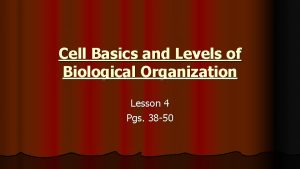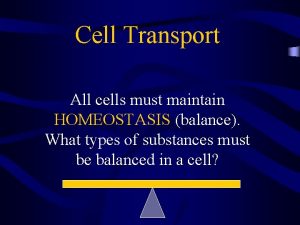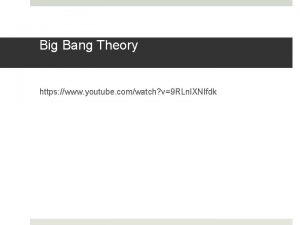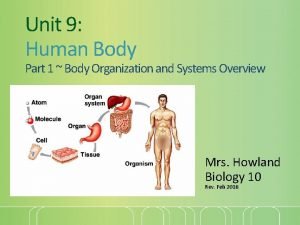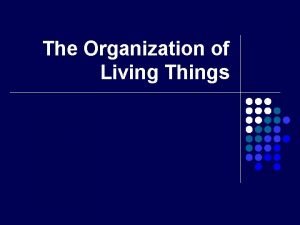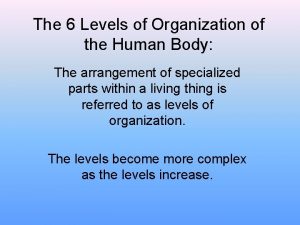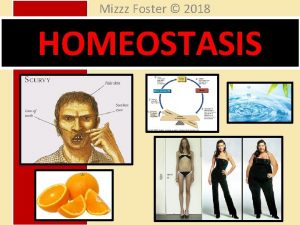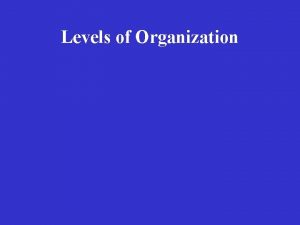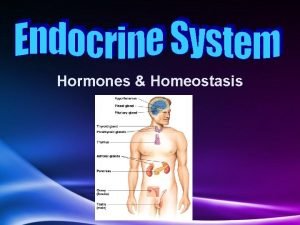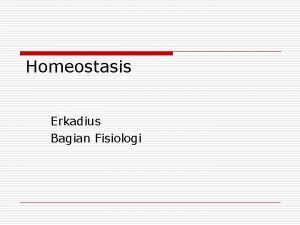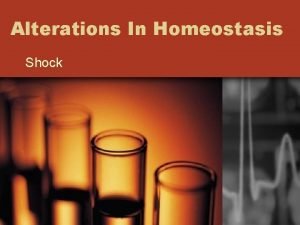Levels of Organization Cell Theory Homeostasis Levels of











- Slides: 11


Levels of Organization – Cell Theory – Homeostasis

Levels of Organization – Cell Theory – Homeostasis

The Cell Theory On an odd page write the question and answer OR restate the question in your answer. 1. What are three postulates of the Cell Theory? 1. All living things are composed of cells 2. Cells are the basic unit of life 3. All cells come from preexisting cells 2. Who used one of the first microscope? • Robert Hooke and Leeuwenhoek 3. How did Leuwenhoek discover bacteria or animalcules? • He studied his own dental plaque and saw unicellular organisms through the microscope. pg. 104 -107

Cell and Homeostasis Reading – Weekly Grade Due end of class 1. Define homeostasis, cellular respiration , photosynthesis. 2. Cellular respiration and photosynthesis are related because both are responsible for making energy for the cell to function / photosynthesis’s output is CR’s input and CR’s output is Photosynthesis’s input. 3. Animal cells do not undergo photosynthesis because animals eat their food and get glucose that way, whereas plants make their food. Organelles Responsible Input Output (waste products) Photosynthesis Chloroplast Carbon dioxide and Sunlight Glucose and Oxygen Cellular Respiration Mitochondria Glucose and Oxygen Carbon dioxide and Energy for cell ( ATP)

5. 6. 7. 8. Define cell membrane and diffusion. Diffusion does not require energy. When waste material builds up it acts as a poison to the cell. Other materials move in opposite direction of diffusion and requires energy to transport the material. 9. The energy need to transport material across the cell membrane comes from cellular respiration. 10. Define cell division. 11. Multicellular organisms use cell division for growth and repair. Unicellular organisms use cell division for reproduction.

Photosynthesis and Cellular Respiration



Organelle How will you remember this organelle? Lysosomes Cell Wall Golgi Apparatus Chloroplast Vacuoles Lysosomes clean the cell – Lysol cleans a house A wall is strong and sturdy – the cell wall is strong and protects the cell Like the post office – sends and receives cell substances Takes in light energy to make food for cell Storage container Cytoplasm Ribosomes Cell Membrane Cytoplasm is gel and hold organelles like hair-gel holds a persons hair Ribs are made of proteins – ribosomes make proteins and start with rib Gate keeper of cell Mitochondria Nucleus Powerhouse of the cell- makes energy Brain of cell , controls all functions , contains the DNA Endoplasmic Reticulum Creates substances for the cell and helps ribosomes make proteins

Lesson Launcher 10/11 All living things contain carbon and are called organic. Anything that has never been alive is called inorganic. Carbon dating and radioactive dating use isotopes to date objects from the past. How is carbon dating and radioactive dating similar and different? Carbon Dating Both • Organic objects ( living) • Use isotopes to date • Accurate for 60, 000 objects from the past • Example of organic: Bone • Can date things that Fossils , Dead leaves, were once alive animals Radioactive Dating • Organic molecules and inorganic molecules (living and nonliving) • +4. 6 billion years old • Example of inorganic: rocks, water, dirt
 Bioflix activity homeostasis low blood glucose
Bioflix activity homeostasis low blood glucose Bioflix activity homeostasis hormones and homeostasis
Bioflix activity homeostasis hormones and homeostasis Levels of biological organization
Levels of biological organization Homeostasis example
Homeostasis example Homeostasis and cell transport
Homeostasis and cell transport Chapter 4 cell theory and cell study
Chapter 4 cell theory and cell study Httpv://www.youtube.com/watch?v=embed/ndg0k7egnmg
Httpv://www.youtube.com/watch?v=embed/ndg0k7egnmg Process organization in computer organization
Process organization in computer organization Point-by-point arrangement
Point-by-point arrangement Body organization
Body organization Organization of living things
Organization of living things 6 levels of organization
6 levels of organization


